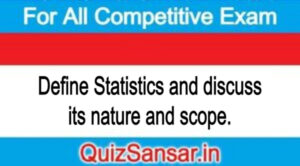
Define Statistics and discuss its nature and scope.
Define Statistics and discuss its nature and scope.
Ans.
Statistics
“By statistics we mean aggregate of facts, affected to a marked extent by multiplicity of causes, numerically expressed, enumerated or estimated according to a reasonable standard of accuracy, collected in a systematic manner for a predetermined purpose and placed in relation to each other.”
Nature of Statistics
Statistics is science as well as arts. Science is a branch of knowledge which possesses, the following characteristics :
(i) Science is a systematic study of knowledge whose methods and laws are interrelated.
(ii) Scientific laws are continuous and of general use.
(iii) It gives importance to cause and effect relationship.
(iv) It is capable of future forecasting on the basis of past and present facts.
All the above characteristics are present in statistics, as such it is called science. It is a systematic study of knowledge. Its laws are certain and are of universal use like other scientific laws. For example, Law of large numbers, future forecasting for population, value etc. are also made under it. As such statistics may rightly be called a science. But it is not similar to exact sciences, like physics, chemistry, zoology etc. This is because statistical laws are generally affected by a multiplicity of causes which cannot be measured accurately. Accordingly to Croxten and Cowden, “Statistics is not a science but it is a scientific method”. Wallis has rightly said that statistics is not a body of substantive knowledge but a body of methods of obtaining knowledge. Statistical laws are less precise than those of natural sciences. As such statistics is a science in limited sense.
Scientific process has four steps (i) Observation, (ii) Hypothesis, (iii) Prediction, and (iv) Verification. All these four steps are adequately used in statistics.
If science is a knowledge, art is an activity. The following are the characteristics of an art :
(i) Art is the skill of handling facts so as to attain a specified objective,
(ii) It not only describes the facts but also prescribes the ways and means to attain objectives.
(iii) It also helps in making inferences logically and drawing conclusions.
From this angle statistics may be regarded as an art also. It involves the application of a given method to achieve facts, derive results and to use them for suitable action. For example, we not only study the method of construction of index numbers, but also study the use of index numbers in making comparisons. As such statistics may be called as a science as well as an art.
Scope and Divisions of Statistics
In ancient times the scope of statistics was very narrow. It was originated as a ‘Science of Kings’. But in the present days its scope has become very wide. In fact, statistical methods are adequately used in every science as a vital tool. It will not be unreasonable to state that “sciences without statistics bear no fruit, statistics without sciences have no roof.”
The subject matter of statistics is divided into two parts:
(a) Statistical Methods,
(b) Applied Statistics.
(a) Statistical Methods
The science of statistics have many methods on the basis of which the data are collected and analysed relating to sphere of any investigation and thereafter conclusions are drawn. In the words of Johnson and Jackson, “Statistical methods are the procedures used in collection, organisation, summary, analysis, interpretation and presentation of data”. According to Yule and Kendall, “By statistical methods we mean specially adapted to the elucidation of quantitative data affected by a multiplicity of causes”.
Statistical facts are made easy and understandable by statistical methods, which can mutually be compared and suitable conclusions could be drawn. Statistics have several important methods which can be divided into four parts.
(1) Collection: It is the first step for any statistical investigation. Under this method it is predetermined for a statistical investigation that when, from where, how many and by which means the data be collected for a suitable study of the problem.
(2) Presentation : Collected data are presented in tables of columns and lines to make them easy, suitable arranged, and comparable. Quantative data may be presented, by means of diagrams and graphs also in an attractive manner.
(3) Analysis: Several procedures are adopted for analysing statistical data by means of classification, measures of central tendency, dispersion, skewness, correlation, construction of index numbers, analysis of time series, interpolation etc.
(4) Interpretation : It is the last stage in statistical investigation. It includes drawing conclusions from data collected and analysed by using various measures of analysis, so that correct and suitable decisions can be taken.
On the basis of functions, statistical methods can be explained of two types (a) Descriptive and (b) Inductive.
(a) Descriptive Statistics
The main function of descriptive statistics is to express the original characteristics of collective statistics. Classification, tabulation, graphic and diagramatic presentation, measures of central tendency are various activities of descripting statistics. On the contrary under inductive statistics, selection of some samples from the whole universe, analysing them and thereafter drawing wise and suitable conclusions for the whole universe by means of estimation, and forecasting methods.
(b) Inductive or Applied Statistics
Under descriptive statistics, statistical methods are used on actual facts, particular subject matter and different problems. In the words of Simson and Kafka, “the applied puts statistical methods into practice in a particular subject matter.” Statistical methods propound various activities and principles where as by applying those principles in actual practice the applicable data are obtained.
Applied statistics further divided into two parts:
(1) Descriptive Applied Statistics : Under this, the past and present data collected pertaining to an area of investigation, are studied, the object of which is to present descriptive information. For example, business data, price-indices, population statistics, etc. are under the area of descriptive applied statistics.
(2) Scientific Applied Statistics : Under this, data are collected for some scientific purpose. It includes methods like association of attributes, correlation, regression etc. which help in establishing functional, relationship between variables. It is often attempted through comparison between two or more sets of data.






